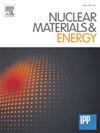High-speed camera observation of Hα, Hβ and Hγ associated with mutual neutralization and EIR in GAMMA 10/PDX divertor simulated plasma
IF 2.7
2区 物理与天体物理
Q1 NUCLEAR SCIENCE & TECHNOLOGY
引用次数: 0
Abstract
For the purpose of gaining a better understanding of detached plasma formation, the transition of the volumetric plasma recombination processes of the end-loss hydrogen plasma of a tandem-mirror, GAMMA 10/PDX, was investigated. In the Divertor Experimental Module (D-module) on the end cell, where the additional hydrogen gas is injected, the plasma flows into the V-shaped tungsten target plates. A 4-branch high-speed camera system was used to observe the 2D distributions of Hα, Hβ and Hγ emission intensities simultaneously. As the neutral gas pressure (pn) in the D-module increased, two distinct emission phases were observed. The first phase was characterized by an initial increase followed by a decrease in Hα emission, coinciding with a rollover of the electron density (ne). This behavior is associated with the mutual neutralization of H+ and H-, a process associated with molecular activated recombination (MAR). Further increase in pn led to the second phase, during which a drastic increase in Hβ and Hγ emissions alongside Hα was seen and the interferometer indicated a re-increase in ne up to at least ∼ 4 × 1018 m−3, while the spectrometer observed an increase in Balmer emission intensities from higher excited states (n ≥ 5). The electron temperature (Te) was estimated to be less than ∼ 0.1 eV using the Boltzmann plot method. These results suggest a shift in the dominant volumetric recombination mechanisms, with mutual neutralization of H2+ and H- becoming significant alongside electron–ion recombination (EIR), a process previously thought to be negligible in GAMMA 10/PDX.
高速相机观察伽玛10/PDX分流器模拟等离子体中与相互中和和EIR相关的Hα、Hβ和Hγ
为了更好地理解分离等离子体的形成,研究了伽玛10/PDX串联反射镜末端损耗氢等离子体的体积等离子体复合过程的转变。在末端电池的分流器实验模块(d模块)中,在那里注入额外的氢气,等离子体流入v形钨靶板。采用四支路高速摄像系统同时观测了Hα、Hβ和Hγ发射强度的二维分布。随着d模块中性气压力(pn)的增加,观察到两个不同的发射相。第一阶段的特征是Hα发射先增加后减少,与电子密度(ne)的翻转相一致。这种行为与H+和H-的相互中和有关,这是一个与分子活化重组(MAR)有关的过程。pn的进一步增加导致了第二阶段,在此期间,Hβ和Hγ的发射与Hα一起急剧增加,干涉仪显示ne再次增加,至少达到~ 4 × 1018 m−3,而光谱仪观察到高激发态(n≥5)的巴尔默发射强度增加。利用玻尔兹曼图方法估计电子温度(Te)小于~ 0.1 eV。这些结果表明,主要的体积重组机制发生了转变,H2+和H-的相互中和随着电子-离子重组(EIR)变得重要,这一过程在GAMMA 10/PDX中以前被认为是可以忽略不计的。
本文章由计算机程序翻译,如有差异,请以英文原文为准。
求助全文
约1分钟内获得全文
求助全文
来源期刊

Nuclear Materials and Energy
Materials Science-Materials Science (miscellaneous)
CiteScore
3.70
自引率
15.40%
发文量
175
审稿时长
20 weeks
期刊介绍:
The open-access journal Nuclear Materials and Energy is devoted to the growing field of research for material application in the production of nuclear energy. Nuclear Materials and Energy publishes original research articles of up to 6 pages in length.
 求助内容:
求助内容: 应助结果提醒方式:
应助结果提醒方式:


